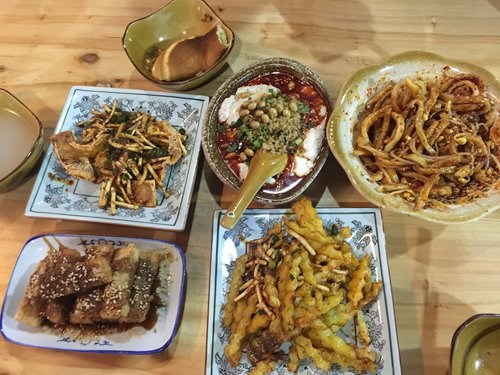
Part of the 1965 series of sculptures Rent Collection Courtyard at Liu's Manor (Photo: Huang Tingting/GT)
Revolutionary memories
Aside from Liu's Manor, the Jianchuan Museum Cluster, just a 10-minute walk from Liu's Manor, is also a popular attraction on Anren's revolutionary-themed itinerary.
Completed in 2006, the private museum area funded by local entrepreneur Fan Jianchuan hosts more than 30 museums focusing on World War II history and China's revolutionary past.
A tourist from Chengdu told me that the site has served as a patriotic education base for school students from major cities for years. She said she still remembers how her schools arranged for them to go on weekend education trips to the site.
It's easy to see the "revolutionary" flavor of the area even before you enter the site as the grey-blue outfits worn by the tollbooth workers at the gate look like the uniforms worn by Red Army soldiers during the 1930s.
Nostalgic signs and symbols can also be seen as you wander between museums.
A souvenir shop near the entry is decorated with revolutionary slogans such as "Rely on yourself to improve your life" and "Strive forward despite the difficult struggle."
The wall of a roadside house was painted with a stern-faced, Red Army soldier standing with his arms wide open - a classic posture often seen in model operas during the Cultural Revolution.
Moreover, there is even a revolutionary-themed hotel on site that claims to be the first place in China to provide a legitimate "Red Era" experience with rooms decorated with revolutionary posters from the 1930s through 1950s as well as quotes from Mao Zedong.
Since I didn't have that much time, I wasn't able to go through all the museums on site. But if you are interested in getting to know more about Chinese history during World War II, I definitely recommend you spend some time roaming these venues.
Another must-see spot is The Chinese Heroes Square. Featuring life-sized copper sculptures of 216 Chinese veterans and martyrs who fought in the War of Resistance against Japanese Aggression (1931-45), the series of sculptures are known as one of the world's largest artworks dedicated to World War II history.
Aside from the two famed historical sites, you might also like to take a look at the residences where Liu's other family members and World War II army leaders once lived decades ago.
Manor-turned-museums
Instead of being located in a protected fenced in site, many of these houses sit right on the old streets along with stores and food stalls. A copper sign and a fancier gate gives some indication that a certain building is different from the rest. Sometimes, visitors have to push through heavy, ancient-style wooden gates themselves to get inside these old mansions.
Luckily, you usually don't have to pay to get in, as many of these residences are now museums open free to the public - but only during designated times.
Inside these buildings, exhibitions showcase the former owners' personal histories and belongings. You can also catch operas based on the story of their lives in some of these residences.
After the local Chengdu Anren Overseas Chinese Town took over the town's tourism projects around 2014, rare and special shows from abroad can also be enjoyed in the town.
The last time I visited one of these buildings in December, a number of cultural relics from The Museum of Nepal were on display. I was a bit surprised to find such a rare collection premiering in a small southwestern town instead of in Beijing, the country's cultural center and go-to place when treasures from overseas national museums make their China debut.
But I soon came to understand why this countryside museum was chosen - you might not be able to find a display room in Beijing that fits so well with the serene atmosphere of the relics on display. The sunlight shining through the ancient building's fissured wood structures made the Nepali Buddhist artifacts look even more sacred.

Local delicacies
After a day of busy walking, you are going to want to sit down for a good meal. The town is known for xiewang - a local stew that mixes pig's intestines, coagulated pig's blood and vegetables with tons of local hot chilies. While the dish's ingredients might sound intimidating for first-timers, I assure you its taste will impress you if you're bold enough to take that first bite.
Like tofu, coagulated pig's blood has a very soft texture. Local chili and peppers added to the stew also help bring out the best flavors of the ingredients.
Other must-try local snacks include Langya potato chips - wavy-shaped potato chips fried with pepper, chili and cumin seeds - Hot and Sour Potato Noodles and Hongtang Ciba, a type of fried glutinous rice cake coated with melted brown sugar.
Rules of thumb:
Getting there: If you go, there are buses at the Jinsha Bus Station in Chengdu that will take you directly to the town. Ticket prices are around 10 yuan ($1.5) per person.
Where to stay: There are plenty of choices of hotels on the town, ranging from a five-star Sheraton to local home-run hotels.




















































